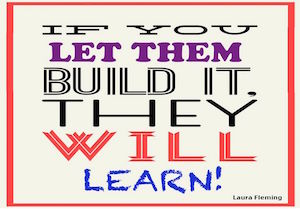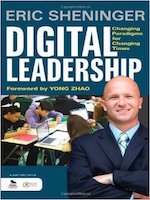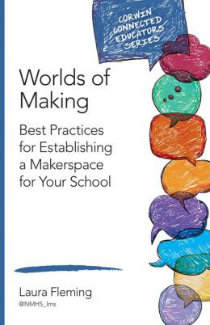Establishing a Making Space in Your School
Worlds of Making: Best Practices for Establishing a Makerspace in Your School
By Laura Fleming
(Corwin, 2015 – Learn more)

If there is a better guide to establishing a school-based center for sparking creative student-based making than Laura Fleming’s small book, I have not yet found it.
In Worlds of Making, Fleming describes her own experiences as a school librarian transforming her library into a vibrant makerspace and offers practical advice for anyone wondering how she went about doing it. Or as she puts it, her book is designed to provide “the nuts and bolts of imagining, planning, creating and managing your own makerspace.”
 What is a makerspace?
What is a makerspace?
Although it does depend on the context, a makerspace is a hands-on center in which learners explore through tinkering, inquiry and reflection by engaging in the “doing” of things, not just reading about ideas.
Every makerspace is different, but many spaces have technology stations where students can make media and engage in remix; an area of manipulative objects for designing and engineering; a work area for tinkering with various pieces of equipment; a robotics area for testing out programming skills; and if you are lucky (as Fleming is) a 3D printing area for more advanced engineering work.
Fleming even has a large interactive board with daily engineering-style problems that students must solve on the screen and a station area where students take apart computers and put them back together again.
From Dewey to Maker Faires
Fleming grounds her ideas in both the philosophy of Dewey – whose hands-on approach to learning is still very pertinent and growing in stature as a counterpoint to the testing era – and the Maker Movement, which has gained much traction in recent years as a way to connect education and arts and engineering communities together in meaningful ways. Events known as Maker Faires are very popular in cities like San Francisco and New York City.
Fundamentally … the Maker Movement is about moving from consumption to creation and turning knowledge into action. In pedagogical terms, it is firmly located within the broadly constructivist philosophies of education.” (Fleming, 7)

Libraries are no longer just quiet study spaces; they are becoming hives of active inquiry. Finding the balance between those two ideals is a key consideration for most libraries these days.
Planning, with administration support
Worlds of Making moves from topics of planning out your makerspace (with an emphasis on involving the students in this stage, so you can align the space and activities to student interests); to setting up your makerspace in a school (with examples ranging from a library space – as Fleming has done – to a corner of a classroom, to a revamped office storage area); to nurturing a culture of making at your own school (which is a huge shift that goes a long way to paving the road for successful implementation of a makerspace); to gathering administrative support for a makerspace.

Making engagement
So, does this makerspace movement help students? Fleming provides examples of her own students as they used her school’s makerspace to launch into inquiry projects and engineering ideas that paved the way for considerations of college programs and the world of work beyond school.
Their tinkering opened up doors that students didn’t know existed before they began to visit the library’s makerspace. Yes, Fleming also connects makerspace projects to Common Core and science standards. (Visit Fleming’s website to see more of what she’s up to.)
But it is the depth of engagement and learning that Fleming showcases that might give more of us the impetus to wonder ourselves: where can our own makerspace go?
[Reviewer disclosure: I was near the end of this book when I saw a reference to myself in the text. Fleming cites a blog post I wrote about 25-word stories, an idea that she used for a project with students.]
Kevin Hodgson is a sixth grade teacher in Southampton, Massachusetts, and is the technology liaison with the Western Massachusetts Writing Project. Kevin blogs regularly at Kevin’s Meandering Mind and tweets more often than is healthy under his @dogtrax handle.



































